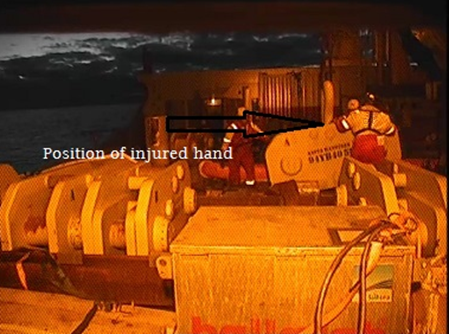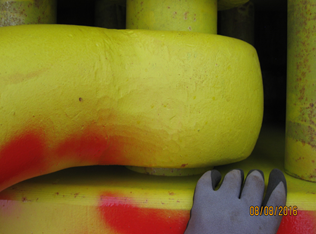Line of fire LTI: Finger injury during lifting operations
A member has reported an incident in which a crewman suffered a serious injury to his left ring finger, resulting in lost work days. The incident occurred when a H-link (rope-rope type) was being relocated from a storage location onto an installation sled. The H-link was lowered horizontally onto the sled with the main crane. The H-link started swinging as it was being landed, and the injured person, who was a flagman during the operation, tried to get it stabilized and into place. As he was trying to stabilize the H-link, his hand got close to the shackle body and due to movement in the shackle, his left ring finger got jammed, leading to a crush injury.
After initial checks and first aid treatment from the on-board medic, the injured person was transferred to a hospital ashore for further treatment.




Our member’s investigation revealed the following:
- Technical findings: the design of the H-link sled gave the deck crew little tolerance to handle the load. The design of the H-link and shackle body was such that it allowed a wide enough gap to get a hand inside;
- Management and supervision: roles and responsibilities on deck were unclear. The injured person, who was a dedicated flagman and should have been supervising the operation, stepped in to stabilize the load;
- Safety controls and systems: the risk assessment used was neither suitable nor sufficient for the task – it had been used a month before, but this earlier risk assessment did not capture the change in method, i.e. using the main crane instead of the rail crane, and it did not highlight the risk of pinch points;
- Methods and procedures: there was no Management of Change (MoC) process for the deviation from the original task plan. This would have included an updated risk assessment, which might have captured the associated risks;
- Attitude and behaviour: insufficient safety awareness from the injured person with regard to the potential risks he faced – he paid no attention to where he put his hand when he was trying to stabilize the load;
- PPE: the deck crew handling the load – all except for the injured person – were wearing impact resistant work gloves. There were no gloves of suitable size available for the injured person, so he was wearing standard gloves. It is not clear whether or not these gloves would have completely eliminated the injury, when such forces have been applied. However, it might have mitigated the injury;
- The underlying causes for the incident were:
- The injured person stepped in to help with stabilizing the load, when he was assigned as flagman for the task and should have been supervising the lift
- The injured person did not pay attention where he put his hand
- The H-link was lifted with the main crane rather than the rail crane
- There had been no MoC in place for this change
- Pinch points were not identified before the start of the operation
- Design of the H-link sled – tight tolerances;
- Neither procedures, nor task plans, described the hazard of these pinch points;
- The root causes for the incident were:
- Lack of safety awareness and understanding of roles and responsibilities on deck
- Inadequate planning of operation, insufficient design, risk assessment and compliance (with MoC process).
The following lessons were learnt:
- Clearer understanding of roles and responsibilities on deck would have ensured that the flagman only supervised the operation and did not handle the load;
- Regular inspection of project equipment on deck would have increased crew familiarity with it and identified pinch points and other potential hazards;
- A more robust MoC process and a suitable and sufficient risk assessment might have prevented this incident.
The following immediate actions were taken once the injured person had been dealt with appropriately:
- Inspection of deck area and H-links to identify other hazardous areas and potential pinch points;
- H-link marked with red paint to highlight potential pinch point areas;
- Method for lifting and landing of the H-link was reviewed;
- Updated task plan/made MoC for the operation, and developed a more detailed risk assessment;
- PPE – evaluate supplying impact resistant work gloves for all deck crew;
- Evaluate and assess design of H-link and H-link sled.
Members may wish to refer to the following incidents (search words: finger, injury):
Members may alsowish to refer to Guidelines for lifting operations.
IMCA publishes a wide range of safety promotional material which is applicable in this instance, including videos, pocket cards and safety posters.
Safety Event
Published: 18 October 2016
Download: IMCA SF 28/16
IMCA Safety Flashes
Submit a Report
IMCA Safety Flashes summarise key safety matters and incidents, allowing lessons to be more easily learnt for the benefit of all. The effectiveness of the IMCA Safety Flash system depends on Members sharing information and so avoiding repeat incidents. Please consider adding [email protected] to your internal distribution list for safety alerts or manually submitting information on incidents you consider may be relevant. All information is anonymised or sanitised, as appropriate.
IMCA’s store terms and conditions (https://www.imca-int.com/legal-notices/terms/) apply to all downloads from IMCA’s website, including this document.
IMCA makes every effort to ensure the accuracy and reliability of the data contained in the documents it publishes, but IMCA shall not be liable for any guidance and/or recommendation and/or statement herein contained. The information contained in this document does not fulfil or replace any individual’s or Member's legal, regulatory or other duties or obligations in respect of their operations. Individuals and Members remain solely responsible for the safe, lawful and proper conduct of their operations.
